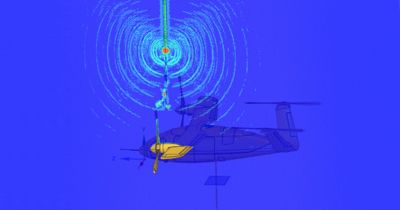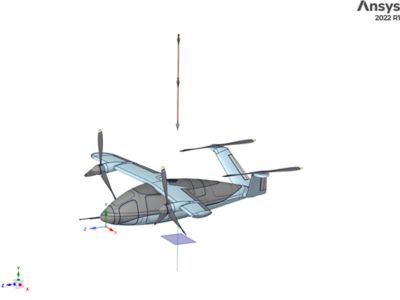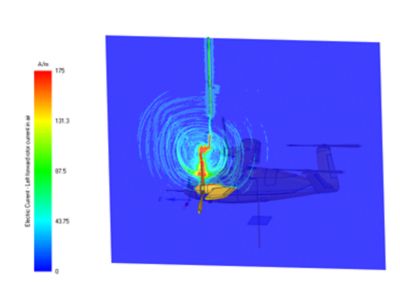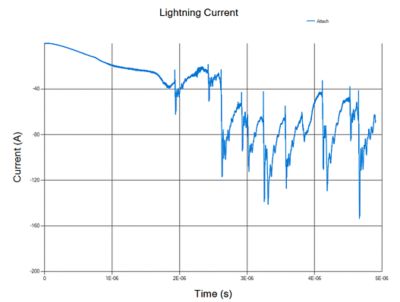ANSYS BLOG
March 28, 2022
The Complexities of Modeling Lightning Strikes on Aircraft
There are anywhere from 40-100 lightning strikes somewhere in the world every second of every day. Commercial and military aircraft are not immune to this phenomenon and are subject to lightning strikes as well.
Lightning effects can lead to total loss of an aircraft if not properly mitigated. The effects of lightning are generally divided between those that impact physical structures (direct effects) and those that impact electronic devices (indirect effects). A significant portion of the cost for development, certification, and modification of air platforms is devoted to analysis, design, and testing of techniques to protect against lightning.
A lightning attachment may occur on the ground up to about 50,000 feet in altitude. All ground structures and air platforms that operate up to 50,000 feet must consider the lightning environment in their design.
One important engineering task is to determine where lightning will attach on an aircraft or another object. The attachment location is a critical issue for aircraft and facility designs.
Lightning initially attaches to the aircraft at one location and exits at one or more locations. More than 90% of aircraft lightning strikes are triggered by the presence of the aircraft itself. In other words, the lightning event would not have occurred without the presence of the aircraft. In the lightning attachment process, leaders originate from the aircraft and propagate into the air a distance of several meters until they intercept the approaching lightning leader, or the region of opposite polarity charge in the clouds.

The first step in protecting aircraft from lightning is to define zones where lightning is likely to strike the aircraft. Aircraft move faster than the lifetime of the lightning event, so there tend to be multiple strike points as the lightning sweeps back as the plane moves forward.
Lightning zoning for aircraft involves separating each aircraft outer surface area into a specific category based on its likelihood for lightning attachment, lightning sweep, and lightning hang-on. The steps required are detailed in the SAE International standard ARP 5414A: Aircraft Zoning. There are three legacy methods to determine the attachment locations:
- Scale-model testing — A small model version of the aircraft is taken to a high voltage lab. The model is adjusted to see where lightning arcs are likely to attach.
- Rolling sphere analysis — A sphere whose radius is related to the possible peak lightning current is rolled over the aircraft outer mold line (OML) to see where an attachment is likely to occur.
- Electric field modeling — Using 3D electromagnetic (EM) simulation, a leader is brought near an aircraft model to see where the electric field (E-field) is most likely to attach.
Though all three are accepted by standards authorities, E-field modeling has the greatest technical basis. Scale-model testing isn’t optimal because the radius of curvature is known to affect the E-field enhancement near an object. By scaling the dimensions of the model, the radius of curvature is adjusted artificially, skewing the results. The rolling sphere method has a long historical heritage for terrestrial installations. However, there has yet to be a first-principles derivation for its effects from the basic physics involved in lightning attachment.
E-field modeling previously used linear methods due to the lack of simulation tools that accurately modeled the non-linear and multiphysics effects of corona in air. However, nonlinear methods are the most accurate and quantitative method of determining lightning attachment location.
EMA3D Charge, a simulation software designed for the analysis of charging and discharging phenomena, includes coupled multiphysics solvers that model the full dynamics of lightning attachment. This tool solves the dynamics of corona effects in air by solving nonlinear air conductivity effects in the time domain. It calculates the densities of positive ions, negative ions, and electrons as a function of space and time.
Physical processes for air ionization and recombination included are electron avalanching, electron attachment to neutral molecules to form negative ions, electron-positive ion recombination, and negative-positive ion recombination.
Fluid dynamics are modeled by solving the fluid equations for momentum, energy, and particle density conservation. These equations include the magnetic and electrical forces on charged particles. The fluid conservation equations solve simultaneously and on the same grid as a solution of Ansys Maxwell’s equations for electrodynamics and the air ionization and recombination equations.
The solver enables engineers to predict where air breakdown and corona will form. Simulated further, it shows the exact location on vehicles and structures where lightning will attach.
In the picture below, we consider a rotorcraft from an electric vertical take-off and landing (eVTOL) platform. The approaching lightning leader is charged with a current source. The eVTOL rotorcraft is connected to the computational boundary.

EMA3D Charge’s nonlinear air chemistry module captures the corona dynamics from the approaching leader. The simulation determines where the lightning will attach. In this case, the attachment is to the rotor itself. This result may not have been assured prior to the simulation.

Because the simulation is dynamic, it can also determine the waveform for the discharge. The recombination dynamics also resolve a reduction in carriers between discharge events.

The solver behind EMA3D Charge’s nonlinear air chemistry module has been validated in a government program, in which an F-106 aircraft instrumented with sensors was intentionally flown into thunderstorms in the hopes of being struck by lightning. After collecting data on 714 lightning strikes, the solver in EMA3D Charge interpreted and reproduced the data1. This influential engineering effort discovered new lightning waveforms and is the basis for many aspects of modern lightning development programs.
EMA3D Charge is a new product from Ansys based on a validated, multiphysics solver that can determine the location of lightning attachment based on specification of the lightning event details. Engineers who design, certify, and test aircraft and structures for lightning must consider the effects of lightning. This effort is a significant percentage of total engineering cost for developing, certifying, maintaining, and upgrading aircraft. One of the most critical tasks for lightning programs is to determine the statistical probability of where each type of lightning event will attach to the platform. Now, the power of EMA3D Charge’s air chemistry solver that enabled this advance is available commercially to all lightning engineers.
References
[1] F. L. Pitts, B. D. Fisher, V. Mazur and R. A. Perala, "Aircraft jolts from lightning bolts (electronic systems protection)," in IEEE Spectrum, vol. 25, no. 7, pp. 34-38, July 1988, doi: 10.1109/6.4573.